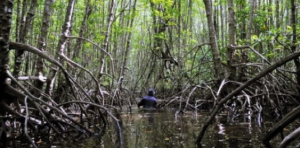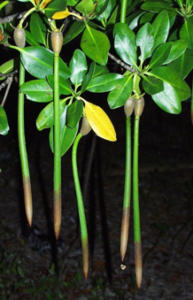Module 6: Forest Types as Related to Their Management
Topic 6.4: Mangrove Forests
Mangroves represent a special case of swamp forests because they are flooded daily or less frequently with salt or brackish water. All over the world, mangrove forests are exploited for the few species of trees that tolerate the combination of flooding and salinity. Mangrove forests are also much utilized for harvesting shellfish, crabs, and other non-timber forest products. Finally, mangrove forests provide critical nurseries and spawning grounds for many species that are harvested in near-shore fisheries.
Mangrove forests vary in productivity due mostly to variation in salinity, flooding frequency, and nutrient inputs. They are most productive in the estuaries of large, sediment-laden rivers where timber yields in managed stands can be substantial. Most mangrove tree species do not coppice, are moderately to very light-demanding, and regenerate well in small clearings. Most species are viviparous and the seedlings are water dispersed (Figure 6.4.1). Where tidal flux is limited, clearings are large, or logging debris impedes dispersal of the floating propagules, regeneration failures can occur. Artificial regeneration with members of the dominant mangrove family, Rhizophoraceae, is technically quite feasible where natural regeneration has failed; the propogules are simply inserted in the ground. There is only one noteworthy weed, a rhizomatous fern (Acrostichum aureum), that can dominate poorly-managed forests at least in Asia.


Figure 6.4.1 Mangrove forest (left) and propagules of a species of Rhizophora (right).
As with other swamp forests, the primary concern with mangrove management is avoiding hydrological changes and soil damage. Chanelization can increase the likelihood of regeneration failures because the receding tides carry away the water dispersed propagules. Drainage can also cause great damage to the soil when the increased aeration causes oxidation of hydrogen sulfide to sulfuric acid; drained mangrove soils can develop pHs as low as 2.9!
The natural disturbance regime of mangroves varies with latitude. In the hurricane and typhoon belts (10-30o N and S, respectively), cataclysmic disturbances are common. Nearer the equator the few mangrove forests that have escaped severe anthropogenic disturbances apparently regenerate mostly in gaps created by lightning, termite attack, or pathogens.
